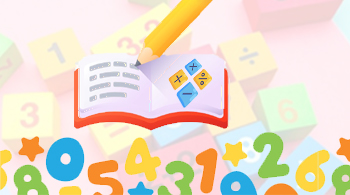Syllabus
Chapter 1: Numbers and Arrays
1.1 Even and Odd Numbers
1.2 Modeling Even and Odd Numbers
1.3 Equal and Unequal groups of Numbers
1.4 Use Arrays
1.5 Make Arrays
Chapter 2: Fluency and Strategies within 20
2.1 Add in Any Order
2.2 Use Doubles
2.3 Add Two and Three Numbers
2.4 Make a 10 to Add
2.5 Count On and Count Back to Subtract
2.6 Relate Addition and Subtraction
2.7 Get to 10 to Subtract
2.8 Practice Addition and Subtraction
2.9 Problem Solving: Addition and Subtraction
Chapter 3: Addition to 100 Strategies
3.1 Add Tens Using a Number Line
3.2 Add Tens and Ones Using a Number Line
3.3 Use Place Value to Add
3.4 Decompose to Add Tens and Ones
3.5 Use Compensation to Add
3.6 Practice Addition Strategies
3.7 Problem Solving: Addition
Chapter 4: Fluently Add within 100
4.1 Use Partial Sums to Add
4.2 More Partial Sums
4.3 Regroup to Add
4.4 Add Two-Digit Numbers
4.5 Practice Adding Two-Digit Numbers
4.6 Add Up to 3 Two-Digit Numbers
4.7 More Problem Solving: Addition
Chapter 5: Subtraction to 100 Strategies
5.1 Subtract Tens Using a Number Line
5.2 Subtract Tens and Ones Using a Number Line
5.3 Use Addition to Subtract
5.4 Decompose to Subtract
5.5 Decompose to Subtract Tens and Ones
5.6 Use Compensation to Subtract
5.7 Practice Subtraction Strategies
5.8 Problem Solving: Subtraction
Chapter 6: Fluently Subtract within 100
6.1 Model and Regroup to Subtract
6.2 Use Models to Subtract a One-Digit Number from a Two-Digit Number
6.3 Use Models to Subtract Two-Digit Numbers
6.4 Subtract from a Two-Digit Number
6.5 Use Addition to Check Subtraction
6.6 Practice Two-Digit Subtraction
6.7 More Problem Solving: Subtraction
Chapter 7: Understand Place Value to 1,000
7.1 Hundreds
7.2 Model Numbers to 1,000
7.3 Understand Place Value concepts
7.4 Write Three-Digit Numbers
7.5 Represent Numbers in Different Ways
Chapter 8: Count and Compare Numbers to 1,000
8.1 Count to 120 in Different Ways
8.2 Count to 1,000 in Different Ways
8.3 Place Value Patterns
8.4 Comparison – More or less
8.5 Compare Numbers Using Symbols
8.6 Compare Numbers Using a Number Line
Chapter 9: Add Numbers within 1,000
9.1 Add 10 and 100
9.2 Add Hundreds and Tens Using number line
9.3 Use a Number Line to Add Three-Digit Numbers
9.4 Use Compensation to Add Three-Digit Numbers
9.5 Use Partial Sums to Add Three-Digit numbers
9.6 Use Models to Add Three-Digit Numbers
9.7 Add two Three-Digit Numbers
9.8 Add Up to 4 Two-Digit Numbers
9.9 Explain Addition Strategies
Chapter 10: Subtract Numbers within 1,000
10.1 Subtract 10 and 100
10.2 Use a Number Line to Subtract Hundreds and Tens
10.3 Use a Number Line to Subtract Three-Digit Numbers
10.4 Use Compensation to Subtract Three-Digit Numbers
10.5 Use Models to Subtract Three-Digit Numbers
10.6 Subtract Three-Digit Numbers
10.7 Subtract from Numbers That Contain Zeros
10.8 Use Addition to Subtract
Chapter 11: Measure and Estimate Lengths
11.1 Measure Lengths in Centimeters
11.2 Measure Objects Using Metric Length Units
11.3 Estimate Lengths in Metric Units
11.4 Measure Lengths in Inches
11.5 Measure Objects Using Customary Length Units
11.6 Estimate Lengths in Customary Units
11.7 Measure Objects Using Different Length Units
11.8 Measure and Compare Lengths
Chapter 12: Solve Length Problems
12.1 Use a Number Line to Add and Subtract Lengths
12.2 Problem Solving: Length
12.3 Problem Solving: Missing Measurement
12.4 Practice Measurement Problems
Chapter 13: Represent and Interpret Data
13.1 Sort and Organize Data
13.2 Read and Interpret Picture Graphs
13.3 Make Picture Graphs
13.4 Read and Interpret Bar Graphs
13.5 Make Bar Graphs
13.6 Make Line Plots
13.7 Measure Objects and Make Line Plots
Chapter 14: Money and Time
14.1 Find Total Values of Coins
14.2 Order to Find Total Values of Coins
14.3 Show Money Amounts in Different Ways
14.4 Make One Dollar
14.5 Make Change from One Dollar
14.6 Find Total Values of Bills
14.7 Problem Solving: Money
14.8 Tell Time to the Nearest Five Minutes
14.9 Tell Time Before and After the Hour
14.10 Relate A.M. and P.M.
Chapter 15: Identify and Partition Shapes
15.1 Describe Two-Dimensional Shapes
15.2 Identify Angles of Polygons
15.3 Draw Polygons
15.4 Identify and Draw Cubes
15.5 Compose Rectangles
15.6 Identify Two, Three, or Four Equal Shares
15.7 Partition Shapes into Equal Shares
15.8 Analyze Equal Shares of the Same Shape

